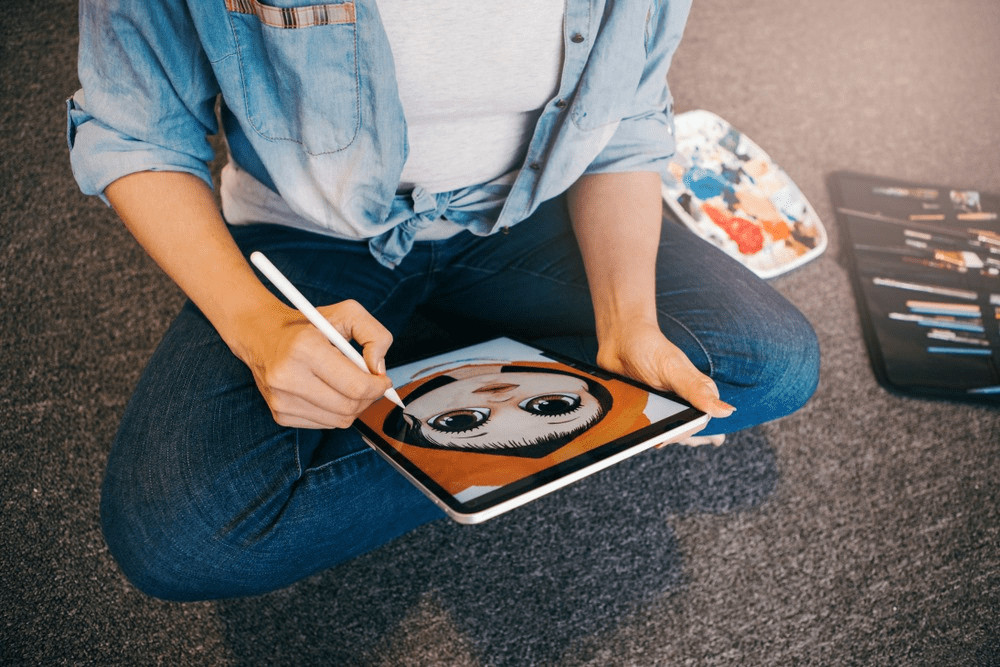The illustrator’s career is gradually becoming more brilliant and flourishing than ever. Vivid images are the best means of connecting readers with the author.
This career also attracts the interest of artists with soaring souls. However, not many people know how to become an illustrator.
Via this article, we will discuss this issue in more depth. Explore the career paths of illustrators and helpful tips on building a portfolio. Let’s start!
What Is An Illustrator?
Illustrators create images to explain a concept or accompany any text. These images will be two-dimensional images with diverse content and styles.
Depending on the different formats, there will be appropriate styles, such as comics, children’s books, and magazines. Besides, illustrators can also be creative with colors, good strokes, and contrast.
Like other art styles, the illustration also evolves and goes with technology.
We begin to familiarize ourselves with the concept of digital illustration to complement traditional hand-drawn art.
The purpose of both traditional and digital illustrators is to decorate, express, and clarify a literary work.

In most people’s subconscious, illustrators usually only focus on children’s books.
While this belief makes some sense that children need drawings to draw attention to content, it is not all.
Adult books like medical textbooks and novels also need drawings to come to life because adults can also lose focus if they look at the text for long periods.
What Does An Illustrator Do?

Besides words and text, images are the best descriptive tools. It opens the audience to a comprehensive and transparent scene right before their eyes.
More than a thick wall of text, an illustration can better convey the essence, meaning, and emotion.
Sometimes, it can stand alone and still convey many messages without needing any explanation.
An illustrator is someone who can create and sketch images based on an idea or represent a textual context.
The workflow of an illustrator includes:
- Discuss the client’s illustration and design needs.
- Negotiate process, price, and deadlines.
- Sketch a sample in advance for the client to comment on.
- Create the final drawing ahead of time.
The work of illustrators will begin with sketches of the ideas they want to implement. After a complete overview of the entire project, these artists will start to paint each image.
Depending on each artist’s style and skills, they can work on digital artboards or paper and pencil.
The most important key in the workflow of an illustrator is listening and understanding.
These artists will need to exchange ideas with the client to reach a consensus. To succeed, besides their natural talent, they need to practice constantly.
Different Types Of Illustrators

There are many different genres of illustrators depending on the type of book that the reader chooses. Some of the most popular careers right now are:
Editorial
The career goal of the editorial illustrator is to create images suitable for magazines, journals, and newspapers.
If they focus on an image, it will be easier to bring out the essence of an idea.
It helps the audience recognize the highlights of the content and sometimes interprets complex texts such as politics or medicine.
There are hundreds of different types of magazines, each suited to a further illustration style.
From photo illustrations and caricatures to minimalist drawings, a team of editors will work together to create a unified set like this.
Product
A product artist will work with a business or individual client to create a finished painting or drawing. They will clarify the product or product features.
These professionals’ products and services include commercial packaging, brochures, online products, and other promotional images.
For product illustrators, the images are their own identity to bring success and tell the product’s story.
By explaining complex features or new concepts visually, users enhance the experience of using the product.
With mechanical, tedious, and exhausting processes such as managing finances, buying gifts, and booking appointments, the images will bring them to life.
In addition, it helps users to pay more attention to faulty or often overlooked processes or features. Besides, users have more context and information to go to the next step.
Besides, the illustrations will create breathing holes to break the limits of the walls of text.
Children’s Book
Children’s book artists provide illustrations that appear alongside text in fiction and non-fiction.
Thanks to these works of art, illustrators can bring a theme or story to life. As a result, their work becomes more attractive, thought-provoking, and colorful.
These artists may work for a publishing company or freelance. However, they will still have to work with publishers throughout the working process.
The most common workflow is for the publisher to send the artist a complete piece of content to illustrate. In that case, the artist and author will rarely collaborate.
Once an agreement is reached, the publisher will arrange the storyboard to show the accompanying images on the different pages.
Artists will create their preliminary images, wait for review and continue to complete them until the end.
Fashion
Fashion illustrators are people who combine skills between painting, fashion, and computers. The focus of this industry is on accessories, style, and related vehicles.
They often work with editorial blogs or fashion magazines to create visually appealing promotional images.
As a result, they encourage customers to choose the clothes, accessories, or jewelry shown.

Storyboard
Storyboard illustrators are responsible for preparing storyboards for mass media such as movies, music videos, TV shows, and commercials.
Years ago, these artists mostly sketched their ideas on paper. Up to now, they have used software like Storyboard Pro or Photoshop to design the story.
The advantage of using software is fixing and making changes quickly.
The work of illustrators will begin when the writer completes the script or idea. For cartoons, the writer and storyboarders will be one.
Storyboards provide direction in product design and a visual idea of the finished product.
During the work, the director can request to edit or remove these scenes if they feel it is necessary.
Medical
Medical illustrators create realistic renderings for their fields. You will see them a lot in advertisements, magazine charts, or in medical textbooks.
Previously, most of these artists focused on working with doctors in medical centers. Their work revolves around creating instructional images and videos for traditional medicine textbooks.
With the development of technology, the opportunities for medical artists have become more abundant.
Some illustrators specialize in creating three-dimensional models. Meanwhile, others target specific markets such as surgical, pharmaceutical, or veterinary.
This work is experiencing strong growth as the public needs a clear picture to understand their health status better.
Technical
Technical illustrators create and design realistic renderings and visualizations for information of a technical nature.
Their major works include technical diagrams, blueprints, and equipment installation graphics in technical publications and manuals.
By drawing information from research data or texts, they can create accurate technical illustrations.
Of course, these professionals also need to have excellent knowledge in their field and a thorough understanding of the process. Their supported software includes Adobe Flash Builder, Photoshop, AutoCAD, and MS Office.
How To Become An Illustrator
According to our research, an illustrator can earn around $70,000 annually. This salary can even increase if you have a lot of experience or are involved in specialized industries.
After taking a closer look at the different types of illustrators, it’s time to dig into the processes for entering the industry.

1. Pursue An Education
First, you should participate in the training program bachelor of fine arts. They offer in-depth training in engineering, computer graphics, and drawing.
Employers expect candidates who have completed a bachelor’s or associate’s degree.
In addition, you can find two-year short-term degree programs that provide additional skills training.
Additional courses will be essential if you want to gain information and knowledge in a specialized profession such as medical or engineering.
2. Identify Your Style
A characteristic of most illustrators is a distinctive and unique point of view and style. You need to focus your search on choosing the profession or technique that makes you stand out as much as possible.
Choose a specific area of illustration that makes you stand out as much as possible. As outlined, there are many different opportunities available to you.
The important thing here is that you should not rush and rush when choosing a particular industry. Experiment with different options before making a decision
If you want to become a medical illustrator, you will need to have a natural talent for drawing human body parts and surgical procedures.
Those who want to focus on fashion illustrators will need the ability to sketch clothes.
Besides, you need to know how to incorporate emotions and inspiration into your illustrations.
3. Do Network
When you go to a bookstore, you will find thousands of genuinely incredible works of art. These fantastic images will bring a lot of inspiration to your work.
However, many people often have excessive self-esteem and compare themselves with other artists. It is a trap.
Instead, find ways to connect with co-workers as much as possible.
The evolution of technology allows you to connect with everyone else more quickly than ever before easily. Take advantage of social media networks like Instagram or Twitter to share your work.
Alternatively, you might consider participating in virtual Meetup events. These events will meet other artists for knowledge and potential business connections.
4. Create A Portfolio
To be seen and observed by more people, you need to do work to promote and display your skills.
The simplest and most effective method is to create an impressive online portfolio to impress employers.
Even if you are just a student and don’t have much experience, you can still add university works and projects to your portfolio.
Also, try searching for any work or projects you work on to enrich your profile.
With the advancement of technology, you have many different options to build an online portfolio and showcase your work. Notable platforms include:
- PortfolioBox
- Behance
- ArtStation
- Dribbble
5. Build A Client Base
Some illustrators work full-time with publishers. At the same time, there are still many freelance artists working on a project-by-project basis.
Start finding new customers if you’re looking to create your own business that doesn’t depend on anywhere else.
Remember that networking and research also take time. You will even have to spend extra time finding and building strong relationships with customers.
It would help if you started working as early as possible while still in school. It will assist in the process of building your customer base.
6. Document Your Growth
If you develop as an illustrator, don’t forget to describe your development.
Always keep your old works. After a while, you can reflect on your old job and learn from it quickly.
Also, try logging your development. You won’t be able to imagine how small details like strokes or illustration tips can make a big difference.
Tips For Creating A Good Portfolio

To create a complete and compelling portfolio, you will need more than just works of art. Some notable tips that you can apply are:
Availability
A professional portfolio to present to potential clients is extremely important. However, you will need an online profile to promote yourself to clients.
Your portfolio should be easily accessible and likely to reflect your capabilities. Don’t forget to list your current contact information.
Type Of Work
To help employers realize your potential, focus only on one specific type of job.
If you want access to more jobs and industries, make sure you can afford it. The portfolio should have a menu-like layout, listing only what you want to sell and take orders for.
Accessibility
Art directors are often very busy and will not have much time to review each individual’s profile.
The key is to keep the artwork on file full-sized and easily accessible. If left as a thumbnail, viewers will have to click and spend a lot of time.
Also, don’t forget to ensure the file size to make sure the web loads faster and lighter.
Measuring Expectations
While the projects you are involved in can certainly demonstrate your talent and technique, they cannot provide indisputable proof of your ability to complete them on time.
However, do not because you randomly add poor quality projects because of the lack of work.
Instead, show your best. Although few, it is still the works that make the strongest impression on viewers.
Conclusion
This article has helped you have the comprehensive and detailed overview of the illustration roadmap. The step-by-step process will include:
- Pursue an education.
- Identify your style.
- Network and make friends.
- Create a portfolio.
- Build a client base.
- Document your growth.
Depending on the type of book you want to illustrate, the skill set will vary. Talent is an indispensable factor, but you need to work more than that.
If you dream of becoming an illustrator, start now! The faster you warm up, the quicker you will reach your goal.
